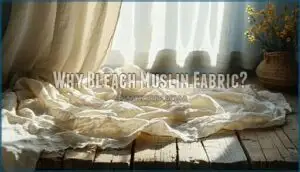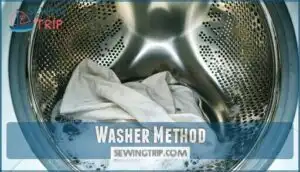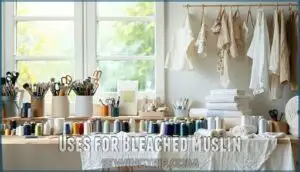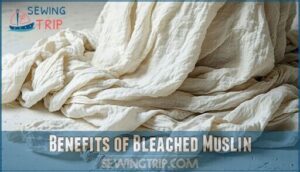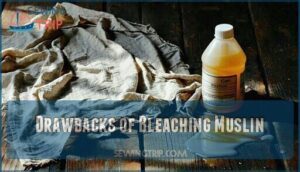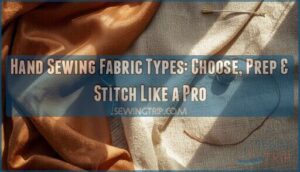This site is supported by our readers. We may earn a commission, at no cost to you, if you purchase through links.

This natural cotton fabric responds well to standard household bleach when you follow proper dilution ratios—typically one part bleach to ten parts water.
You can bleach muslin in your washing machine or bathtub, though the process requires safety precautions like good ventilation and protective gloves.
Bleaching also whitens the fabric and softens those sometimes-scratchy fibers, making muslin more comfortable against skin.
The transformation from that natural beige tone to bright white opens up countless possibilities for dyeing, painting, and creating custom pieces that’ll make your next project shine.
Table Of Contents
Key Takeaways
- You can safely bleach muslin fabric using a 1:10 bleach-to-water ratio in your washing machine or bathtub – just soak for 5-30 minutes depending on how white you want it.
- Bleaching transforms muslin’s natural beige color into bright white while softening the fibers, making it perfect for dyeing and crafting, and creating custom projects.
- You’ll need proper ventilation and protective gloves when bleaching, plus thorough rinsing afterward to remove all chemical residue before use.
- Bleached muslin works great for photography backdrops, quilting, baby items, and home decor – but overbleaching can weaken the cotton fibers permanently.
What is Muslin Fabric?
Muslin fabric is your crafting companion—a lightweight, plain weave cotton textile with an open structure that makes it incredibly versatile. This breathable material comes from cotton sources and features various muslin weaves, from delicate gauze to sturdier cambric grades.
You’ll find different fabric weights available, each serving specific muslin applications. Lightweight versions work perfectly for baby blankets and cheesecloth, while heavier weights handle photography backdrops and theater props. The fabric’s breathability keeps you comfortable in garments and allows air to flow freely through home decor items.
What makes muslin special? Its affordability and dye-absorption properties. You can bleach muslin fabric easily at home, transforming off-white material into bright white. The open weave structure means bleaching muslin works quickly and effectively. Whether you need muslin fabric bleach treatments for crafting or want to can bleach muslin for photography, this cotton responds well to whitening processes. Understanding these basics helps you choose the right muslin fabric bleach approach for your project.
Why Bleach Muslin Fabric?
You’ll want to bleach muslin fabric for two main reasons: whitening and softening.
Bleaching removes the natural yellowish tint from unbleached muslin while breaking down fibers to create a softer, more supple texture that’s perfect for crafts and garments.
Whitening
Your muslin’s natural cream or yellow tones disappear when you bleach muslin fabric effectively.
Achieving brightness requires proper bleach alternatives like hydrogen peroxide or oxygen bleach for gentler whitening muslin results.
How to bleach muslin depends on shade control – lighter concentrations prevent damage while still providing yellowing prevention.
Whitening agents work by breaking down color compounds, transforming your fabric into a crisp, clean canvas.
Bleaching white muslin removes manufacturing residues and natural oils for professional-quality results.
Softening
Beyond whitening, fiber breakdown during bleaching creates incredible fabric softness you’ll appreciate.
Bleaching transforms rough muslin into luxuriously soft fabric perfect for any project.
The chemical process naturally loosens cotton fibers, eliminating the need for traditional fabric softeners.
Consider bleach alternatives like hydrogen peroxide or natural softeners such as white vinegar for gentler softness enhancement.
These chemical alternatives provide similar softening benefits without harsh environmental impact.
For maximum softness longevity, rinse thoroughly after treatment and air-dry flat.
This fabric softening technique transforms stiff muslin into luxuriously soft material perfect for crafting projects.
How to Bleach Muslin at Home
Before diving into the specifics, you’ll want to prepare your workspace and materials for safe bleaching muslin at home. This process requires careful attention to bleach concentration and proper ventilation to achieve professional results.
Start by pre-washing your muslin with mild detergent to remove surface oils and dirt. Here’s your essential setup checklist:
- Prepare your bleach solution: Mix chlorine bleach with water at ½ cup per gallon for safe bleach concentration
- Choose your workspace: Work in a well-ventilated area to minimize chemical exposure risks
- Gather neutralizing supplies: Keep hydrogen peroxide ready for neutralizing bleach after treatment
- Plan your drying methods: Set up outdoor drying space for natural sunlight acceleration
For bleaching techniques, soak your muslin for 30-60 minutes depending on desired whiteness. Remember that you can maintain softness by using cold water washing. Monitor the fabric closely—overexposure weakens cotton fibers.
When exploring bleach alternatives, consider natural options like lemon juice and sunlight for gentler treatment. Always rinse thoroughly until water runs clear, removing all residue before implementing your chosen drying methods.
Bleaching Methods for Muslin
You can bleach muslin using two main methods: the washing machine or a bathtub soak.
Both approaches effectively whiten and soften your fabric when you follow the proper ratios and timing, which includes using the proper ratios.
Washer Method
When using a washing machine for bleaching muslin, you’ll achieve consistent results across large fabric pieces.
Add 1/2 cup bleach per gallon of water to your washer drum before loading pre-wetted muslin. Choose hot water settings for better bleach activation and run a 10-30 minute cycle depending on desired brightness. Always include an extra rinse cycle to remove residual chemicals.
Remember that cold water is preferable for regular washing to prevent damage.
| Setting | Recommendation | Purpose |
|---|---|---|
| Water temperature | Hot (140°F+) | Activates bleach effectively |
| Cycle length | 10-30 minutes | Controls brightness level |
| Load size | Medium or less | Guarantees proper agitation |
This washer method works perfectly for bleaching muslin used in photography backdrops and craft projects, delivering professional-looking results with minimal effort.
Bathtub Method
If your washing machine can’t handle large muslin pieces, try the bathtub method for bleaching muslin.
Fill your tub with hot water and add bleach using a 1:4 ratio—about ¼ cup bleach per gallon of water temperature around 140°F works best. Submerge your muslin completely, guaranteeing even coverage.
The soaking time should range from 5-30 minutes depending on desired whiteness. Gentle agitation techniques help distribute the solution evenly.
This safe bleach muslin approach removes impurities effectively. Always wear gloves and make certain proper ventilation when using this muslin bleaching tips method.
After bleaching, rinsing thoroughly with cold water removes all chemical residue. This bleaching guide muslin technique transforms fabric beautifully. Bleaching enhances brightness, softness, and, according to some, increases fabric purity.
Uses for Bleached Muslin
Once you’ve bleached your muslin fabric, you’ll discover it’s perfect for countless creative projects around your home.
The bright white base makes it ideal for crafts, clothing construction, and decorative applications that require a clean, neutral foundation.
Crafts
Bleaching muslin opens doors to countless craft projects. Transform plain fabric into stunning creations that’ll impress anyone who sees your handiwork.
- Quilt Backing: Perfect lightweight foundation for cozy quilts
- Muslin Dyeing: Accepts vibrant colors beautifully after bleaching
- Craft Projects: Ideal canvas for painting, stamping, or embroidery
- Muslin Blending: Combines well with other fabrics in mixed-media art
- Fabric Manipulation: Easy to gather, pleat, or sculpt into desired shapes
DIY enthusiasts love bleached muslin’s versatility for creating photo backdrops, table runners, and gift bags.
You can even find various muslin products online for your projects.
The soft texture makes it perfect for baby items like bibs and burp cloths too.
Clothing
Bleached muslin transforms into comfortable, breathable clothing options.
You’ll find dyeing muslin creates vibrant garments with enhanced clothing durability after bleaching muslin properly.
The softened fibers improve clothing comfort substantially.
Fashion applications include lightweight shirts, pajamas, and undergarments.
Proper muslin fabric care maintains these benefits.
Your bleached fabric accepts dyes beautifully, making custom clothing projects achievable with minimal fabric care requirements, resulting in breathable clothing.
Decor
Transform your living space with bleached muslin’s versatile decor applications.
You’ll love how it creates stunning window treatments with perfect curtain sheerness for soft, filtered light.
This lightweight fabric excels as furniture covers and slipcover styles that protect while adding casual elegance.
For home decor projects, muslin fabric whitening prepares the perfect canvas for decor dyeing in custom colors.
Photography backdrops benefit from its clean appearance, while proper muslin fabric care guarantees longevity for all decorative uses.
Benefits of Bleached Muslin
Bleaching muslin transforms ordinary fabric into a versatile material that’s perfect for your creative projects.
You’ll enjoy improved softness, enhanced whiteness, and better moisture-wicking properties that make bleached muslin ideal for everything from photo backdrops to baby clothes, with better moisture-wicking properties.
Softening Drop Cloths
Drop cloths straight from the hardware store feel rough as sandpaper. Bleached muslin transforms these stiff sheets into workable fabric through dropcloth fiber breakdown. Pre-softening methods using warm water soaks prepare fibers before your main project.
Here’s how bleach-free softening creates lasting results:
- Vinegar rinse – Natural alternative softeners break down residual sizing without chemicals
- Multiple wash cycles – Gradual fiber relaxation maintains softness longevity better than harsh treatments
- Air-dry flat – Prevents stiffening that machine drying causes in white drop cloths
Your softening drop cloths process makes muslin fabric whitening more effective while preserving benefits of bleached muslin. To maintain the fabric’s integrity, avoid using traditional fabric softeners, as they can reduce absorbency.
Whiter Backdrop Material
For photography projects, bleached muslin delivers exceptional bleaching results that create professional whiter backdrop material.
The enhanced light reflection from bleached muslin backdrops improves studio lighting conditions substantially.
You’ll notice improved wrinkle resistance and superior texture quality compared to unbleached alternatives.
Professional photographers choose various backdrop sizes of bleached muslin because it helps brighten studios naturally while providing clean, neutral backgrounds for portrait work.
Moisture-Wicking Properties
Beyond clean backdrops, bleached muslin delivers impressive moisture-wicking properties that keep you comfortable.
Its natural moisture-wicking abilities absorb sweat efficiently while the open weave structure promotes faster drying time.
Here’s why fabric breathability matters:
- Athletic applications benefit from superior sweat absorption
- Comfort level increases during physical activities
- Moisture wicks away from skin three times faster than dense cotton
- Open weave maintains airflow above 110 cm³/cm²/sec
- Enhanced breathability prevents bacterial growth and odors
Drawbacks of Bleaching Muslin
Several drawbacks make bleaching muslin risky for your projects.
Bleaching muslin transforms your fabric—but at what cost to durability and safety?
Caustic bleach degrades natural cotton fibers, making them brittle and prone to tearing.
Frequent bleaching accelerates wear, reducing fabric lifespan by half.
You’ll face fiber damage through cellulose breakdown and visible pilling.
Color fading becomes unpredictable, creating patchy or mottled appearances.
Synthetic blends suffer worse damage since bleach destroys polyester and acrylic materials.
Environmental impact includes toxic wastewater that disrupts ecosystems.
Skin irritation occurs from residual chemicals, especially problematic for baby items.
Test inconspicuous areas first and consider testing fabric dyes to prevent unwanted color changes.
Test inconspicuous areas first and consider gentler alternatives like hydrogen peroxide.
Where to Buy Bleached Muslin Fabric
Finding quality bleached muslin doesn’t have to feel like searching for a needle in a haystack. Online retailers like Joanns, Walmart, and Amazon offer convenient shopping with competitive pricing and detailed product descriptions.
You’ll find options ranging from lightweight gauze to heavier utility-grade fabric, typically priced between $2-7 per yard. Local stores provide hands-on fabric quality inspection before purchase.
Chain retailers stock bleached muslin in their quilting and apparel sections, while specialty fabric stores often carry wider widths perfect for backdrops. Don’t overlook hardware stores selling white cotton drop cloths—they’re economical alternatives for large projects.
You can easily find various options online. For bulk discounts, consider wholesale suppliers offering rates as low as $1-3 per yard on orders over 100 yards.
Compare pricing across multiple sources, checking thread count and finishing processes. Whether you need a few yards for crafts or bolts for commercial use, pre-bleached muslin saves time and guarantees consistent results.
Frequently Asked Questions (FAQs)
Can you bleach muslin?
Like cotton soaking up sunshine, you can definitely bleach muslin fabric to achieve a bright, clean white.
Use diluted bleach solutions, soak briefly, rinse thoroughly, and always check care labels first.
How to make muslin cloths white again?
Soak your muslin cloths in hot water with diluted bleach at a 1:10 ratio for 30 minutes. Rinse thoroughly until water runs clear, then air-dry in direct sunlight.
What are the disadvantages of muslin fabric?
Like a double-edged sword, muslin’s delicate nature means you’ll face fraying edges, wrinkles that resist pressing, shrinkage during washing, and limited durability compared to heavier cotton fabrics.
Can bleach damage muslin fabric permanently?
Yes, bleach can permanently damage muslin fabric if you use it incorrectly.
Overconcentration, extended soaking, or high temperatures weaken cotton fibers irreversibly.
Always dilute properly and limit exposure time to prevent lasting harm.
How long should you soak muslin?
Bleaching theory suggests timing controls fabric integrity—too short won’t whiten effectively, too long damages fibers.
You’ll want to soak muslin for 5-10 minutes: five minutes removes stains, ten minutes lightens color substantially.
What bleach concentration is safest for muslin?
Use a 1:10 bleach-to-water ratio for gentle whitening, or 1:5 for brighter results. You’ll protect delicate fibers while achieving your desired brightness without damaging the fabric’s integrity.
Can you bleach colored muslin fabric?
Like turning a vibrant sunset into moonlight, colored muslin transforms dramatically under bleach’s power.
You can bleach colored muslin, but it’ll strip the original color, leaving unpredictable results—sometimes patchy whites or faded hues instead of pure white.
Is bleached muslin safe for babies?
Properly bleached muslin that’s thoroughly rinsed is safe for babies. However, you’ll want to wash it multiple times after bleaching to remove any chemical residue before skin contact.
Conclusion
Like a magic wand transforming ordinary fabric into pure potential, bleaching muslin opens endless creative doors.
Yes, you can bleach muslin fabric using simple household methods that deliver professional results.
The washing machine and bathtub approaches both work effectively when you follow proper ratios and safety guidelines.
Bleached muslin becomes softer, brighter, and more versatile for your next project.
Whether you’re creating backdrops, crafting quilts, or designing clothing, this affordable transformation gives you a clean canvas ready for dyeing or decorating.
- https://mypacklove.com/blog/label/bleaching-clothes-safely-protect-your-apparel-stock/
- https://www.badeloftusa.com/how-to-guides/clean-bathtub/
- https://www.internationaljournalssrg.org/IJPTE/2020/Volume7-Issue1/IJPTE-V7I1P106.pdf
- https://muslindhaka.com/bleached-muslin-fabric/
- https://thunderbaymuseum.wixsite.com/behindtheseams/post/the-land-of-milk-and-urine-a-brief-history-of-textile-bleaching

